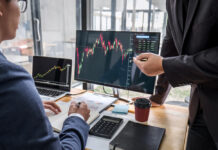In 2026, financial trading isn’t confined to Wall Street floors or high-rise offices. Thanks to technology, anyone with discipline, curiosity, and an internet connection can learn to trade from home.
But here’s the truth: while trading can offer flexibility and freedom, it’s not a quick-rich scheme. Most traders who succeed do so through education, strategy, emotional control, and risk management.
In this guide, you’ll learn how to become a financial trader from home — the right way. You’ll discover practical steps, real-world insights, and tools used by professionals worldwide.
The Harsh Realities Most Websites Never Tell You
-
90% of retail traders lose money in their first year.
-
You need 6–12 months of study before seeing consistency.
-
Psychology beats strategy — fear, greed, and FOMO destroy beginners.
-
Meaningful income requires capital ($5,000–$10,000+).
-
Taxes matter — short-term gains are taxed as ordinary income.
What Is a Financial Trader?
A financial trader buys and sells financial instruments like stocks, forex, commodities, cryptocurrencies, or derivatives to earn profit from market movements. Traders rely on data, charts, and news to make informed decisions.
Types of traders include:
-
Day Traders – Execute multiple trades daily for short-term profit.
-
Swing Traders – Hold positions for several days or weeks.
-
Position Traders – Focus on long-term trends and fundamental data.
-
Algorithmic Traders – Use code and data models to automate trading.
Salary & Earnings Potential
| Experience Level | Average Annual Earnings | Notes |
|---|---|---|
| Beginner (0–1 yr) | $0 to negative returns | Learning phase; small accounts |
| Intermediate (1–3 yrs) | $20,000–$50,000 | Small consistent gains |
| Advanced (3–5 yrs) | $50,000–$150,000 | Multiple strategies |
| Professional (5+ yrs) | $100,000–$500,000+ | Prop firms or institutional |
Why Trading from Home Makes Sense in 2026
Working from home as a trader combines flexibility with opportunity:
-
Remote-friendly: All you need is a laptop, internet, and a trading platform.
-
Flexible schedule: You can trade before work, during lunch, or at night.
-
Scalable: Start with a small account and grow gradually.
-
Accessible: Demo accounts and global education platforms make it easier than ever to start.
The world’s financial markets run 24/7 — from the Tokyo Stock Exchange to London’s FTSE to New York’s NASDAQ — making trading a truly global opportunity.
Phase 1: Learn the Fundamentals
1. Understand How Markets Work
Start by grasping the basics of supply and demand, market orders, bid-ask spreads, and price action. You should understand what moves prices — from earnings reports and geopolitical news to central bank policies.
Study:
-
Technical analysis: Charts, indicators, and candlestick patterns.
-
Fundamental analysis: Company data, economic news, and macro trends.
-
Sentiment analysis: Crowd psychology and investor behavior.
2. Take an Educational Route
While a degree isn’t required, knowledge is. You can learn through:
-
Free courses: Coursera, Investopedia Academy, Babypips (for forex).
-
Books: Trading for a Living by Dr. Alexander Elder, Market Wizards by Jack Schwager.
-
Webinars & podcasts: Many brokers host live sessions for beginners.
Pro tip: Dedicate at least 3–6 months to learning before trading real money.
Phase 2: Choose Your Market and Trading Style
Each market has its own risk-reward profile. Here’s a comparison:
| Market Type | Example Instruments | Common Platforms | Risk Level |
|---|---|---|---|
| Stock Trading | Apple, Tesla | E*TRADE, TD Ameritrade | Medium |
| Forex Trading | EUR/USD, GBP/JPY | MetaTrader 4, TradingView | High |
| Commodities | Gold, Oil | Interactive Brokers | Medium |
| Crypto Trading | Bitcoin, Ethereum | Binance, Coinbase | High |
| Derivatives | Options, Futures | Thinkorswim, NinjaTrader | High |
Phase 3: Master Risk and Money Management
Most traders fail because they don’t manage risk. Learn the 1–2% rule — never risk more than 2% of your capital on a single trade.
Key risk tools:
-
Stop-loss: Automatically closes a losing trade.
-
Take-profit: Locks in gains.
-
Risk/reward ratio: Aim for 1:2 or better (risk $1 to make $2).
-
Position sizing: Adjust trade size based on account equity.
Example: If you have $1,000, risking 2% means $20 per trade.
“Professional traders focus on surviving first — profits come second.”
Phase 4: Pick a Reliable Trading Platform
When trading from home, your platform is your command center.
Look for:
-
User-friendly interface (ideal for beginners)
-
Integrated education & analytics
-
Fast execution speed
-
Access to demo accounts
Top choices globally: MetaTrader 4/5, TradingView, Interactive Brokers, Thinkorswim, CMC Markets.
Overview of Global Financial Markets
Global Financial Markets Overview
Understanding global financial markets is essential for traders operating in today’s 24/7 digital economy.
Major Exchanges: From the NYSE in the U.S. to the NSE in India and the Tokyo Stock Exchange, global markets offer diverse trading opportunities.
24-Hour Market Cycle
- Asia Session: Tokyo, Hong Kong, Sydney
- European Session: London, Frankfurt
- US Session: New York, Chicago
Why This Matters: Knowing when global markets overlap can help you identify periods of high liquidity and volatility—ideal times to trade.
Consider including a 24-hour forex or stock market clock visual to help readers grasp this.
Phase 5: Practice Before You Trade
Before risking real capital, use a demo account to practice.
Treat it seriously — track trades, test setups, and note results in a trading journal.
Focus on:
-
Learning to identify setups (breakouts, trend reversals).
-
Practicing discipline with stop-losses.
-
Building confidence before going live.
After 3–6 months of consistent demo results, transition to a small live account.
Phase 6: Develop a Trading Plan
A strong trading plan includes:
-
Your market: Forex, stocks, or crypto.
-
Trading hours: When global markets overlap (e.g., London–New York session).
-
Entry/exit rules: Based on clear setups.
-
Risk rules: Maximum loss per day/week.
-
Review process: Weekly journaling and analysis.
A trading plan removes emotion and keeps decisions objective.
Phase 7: Learn Trading Psychology
Emotions can destroy a trader faster than bad strategy.
Key psychological traps:
-
FOMO (Fear of Missing Out) — chasing late entries.
-
Revenge trading — trading emotionally after losses.
-
Overconfidence — increasing risk after wins.
Develop emotional discipline through journaling and routine.
“A good trader doesn’t predict — they react calmly to what the market does.
Phase 8: Go Live — Start Small
Start with a small amount (even $100–$500). Focus on process, not profit.
Use a micro account to trade fractional positions and limit losses.
Recommended approach:
-
Trade 1–2 high-quality setups per day.
-
Keep a trading journal with screenshots.
-
Review performance weekly.
Example entry:
“Bought EUR/USD at 1.0950 on trendline bounce. Stop-loss: 1.0920. Take-profit: 1.1010. Rationale: Bullish daily momentum and positive CPI data.”
Phase 9: Continuous Improvement and Strategy Building
Once you have consistent demo results, build your edge by backtesting and refining strategies.
Try:
-
Backtesting: Use past data to test your method.
-
Paper trading: Practice in real-time without risk.
-
Automated tools: Test trading bots or scripts cautiously.
Learn from other successful traders through forums like TradingView Community or Reddit r/Forex.
Phase 10: Think Like a Professional
If trading becomes more than a hobby, explore these professional paths:
-
Proprietary Trading Firms (Prop Firms): Get funded after an evaluation (e.g., FTMO, TopStep, The5ers).
-
CFA or CMT Certification: Build credentials and knowledge depth.
-
Mentorship or Trading Communities: Learn advanced setups and market behavior.
Professional traders treat trading like a business — tracking expenses, optimizing setups, and continuously studying global markets.
Common Beginner Mistakes to Avoid
-
Overtrading: Quality > Quantity.
-
Ignoring stop-losses: Always use them.
-
No plan: Guessing is gambling.
-
Trading based on emotion: Stay data-driven.
-
Neglecting reviews: Track every trade and learn weekly.
Certification Comparison
| Certification | Cost | Time | Best For | Worth It? |
|---|---|---|---|---|
| CMT | $2,000–$3,000 | 18–24 months | Technical traders | ⭐⭐⭐⭐⭐ |
| Series 57 | $200–$500 | 2–3 months | Prop firms | ⭐⭐⭐⭐ |
| CFTe | $1,500 | 12 months | International traders | ⭐⭐⭐ |
| No certification | $0 | None | Self-taught beginners | ⭐⭐ |
Example Daily Routine for a Part-Time Trader
| Time | Task |
|---|---|
| 7:30 AM | Read market news (Bloomberg, Reuters, CNBC). |
| 8:00 AM | Review charts and mark setups. |
| 9:00 AM | Execute trades (risk 1–2%). |
| 6:00 PM | Review outcomes and journal notes. |
| Weekend | Backtest and refine trading plan. |
Realistic Expectations
Trading is a long-term journey.
-
It may take 6–12 months to achieve consistency.
-
Expect both winning and losing streaks.
-
Focus on skill mastery, not fast profits.
“The best traders aren’t lucky — they’re consistent, patient, and disciplined.”
Final Thoughts: Can You Do This?
Let’s Wrap This Up
FAQS:
Q1. How long does it take to become a financial trader?
A1. It varies, but most traders gain proficiency within 6–12 months through education, practice, and demo accounts.
Q2. Can I trade from home?
A2. Yes. Online trading platforms allow traders to operate remotely with reliable internet and proper tools.
Q3. What qualifications do I need?
A3. While a degree isn’t mandatory, a background in finance, economics, or mathematics helps. Certifications like CMT or Series 7 add credibility.
Q4. How much capital do I need to start trading?
A4. It depends on the market and platform. Start small to manage risk, then scale gradually.
Q5. What are the best trading platforms for beginners?
A5. MetaTrader 4, TradingView, Thinkorswim, E-Trade, and Interactive Brokers are popular beginner-friendly platforms.
Find a Home-Based Business to Start-Up >>> Hundreds of Business Listings.
















































